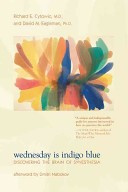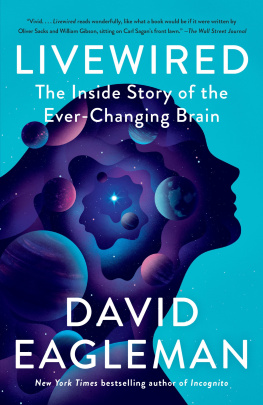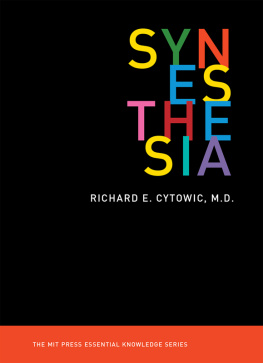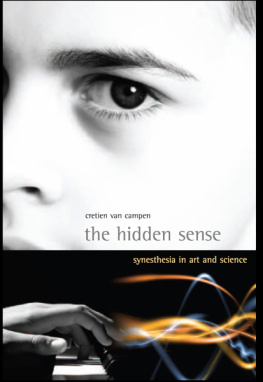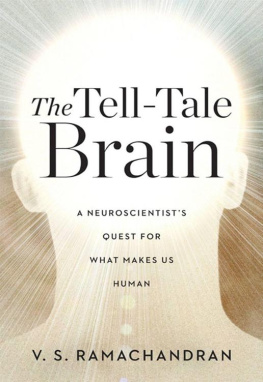Contents
Introduction vii
1 What Color Is Tuesday? 1
2 A Kaleidoscopic World 23
3 Don't It Make My Brown I's Blue? 63
4 See with Your Ears 87
5 November Hangs above Me to the Left
6 A Matter of Taste 127
7 Auras, Orgasms, and Nervous Peaches
8 Metaphor, Art, and Creativity 163
9 Inside a Synesthete's Brain 199
10 Questions Ahead 235
Afterword by Dmitri Nabokov 249 Notes 255 Bibliography 281 Index 301
A Matter of Taste
Taste and smell are intimately relatedso much so that people are surprised to learn that what they think of as taste is more often a matter of smell. Foods lose their flavor when you have a cold because of your diminished sense of smell. What people commonly experience as flavor is actually a compound sensation of discriminating basic tastes (sweet, salty, bitter, sour, meaty)1 along with smell, temperature, and texture. Compared to our small handful of taste receptors, we possess about 1,000 olfactory receptors, the result being that aroma sensations are far more diverse than taste sensations.
To prove the importance of smell to tasting, you have only to hold your nose or put a clothespin on it while sampling a variety of foodstuffs. Do this and you will discover how bland or tasteless many foods become. For example, you will be unable to distinguish an apple from an onion, or coffee from tea. The latter two will taste only mildly bitter and unpleasant because it is their robust aromas that give each beverage its characteristically complex flavor. In using the term "flavor," we therefore mean to include both taste and smell unless specifically stating otherwise.
Taste and smell differ from other senses in being chemically basedthat is, they rely on the dissolving of chemical molecules in the tongue's taste buds or mucous membranes of the nose and throat, as opposed to the transduction of electromagnetic forces (vision) or mechanical ones (touch and hearing). As such, taste and smell are organized much differently in the brain than vision, hearing, and touch are. For one thing, the nerves carrying smell information do not pass through the waystation of the brain's thalamus, instead synapsing directly in the cortex at the bottom surface of the frontal lobes. This ancestrally old part of the brain is called the "rhinencephalon," literally the "smell brain."
The primary cortical taste area lies in a spot on the side of the brain called the operculum, with secondary taste areas further back in the parietal lobe and deeper in from the temple within a region called the limen insula (see figure 6.1). Damage here impairs the recognition of food type and flavor intensity.2 Figure 6.2 shows the cortical components of an aroma network.3 Over half the neurons in the primary taste areas are also sensitive to texture and temperature.
It is little appreciated how cross-sensory perceptions occur routinely in olfaction. In a technical sense, we might say that everyone is synesthetic.4 For example, certain odors such as vanilla are consistently said to smell sweet, even though sweetness belongs to the domain of taste.5 In fact, "sweet" is the most common description of odor. When one researcher asked 140 participants to describe a strawberry odor, 79% said it smelled sweet whereas only 43% said it smelled like strawberry and 71% that it was fruity.6 Many similar examples (such as amyl acetate, commonly used as banana flavoring) yield the same result: when smelling an odor, more
people perceive taste-like qualities such as sweetness rather than specific ones such as strawberry-likeness or banana-likeness.
Given the dramatic effect of smell on taste perception, it is therefore ironic that we have few, if any, words to primarily describe smells. Rather, we borrow nearly all of them from other senses as revealed by terms such as "sweet," "sharp," "bright," "clean," "fresh," "soft," or "spicy." Terms used for smells usually refer to their typical causes, for example, "floral," "fruity," "moldy," or "acrid."
As in true synesthesia, the reliability of ratings such as sweetness as measured by test-retest correlations is stable over long periods of time. Their validity is likewise shown by the phenomenon of sweetness enhancement. That is, when a sweet-smelling odor is added to a sugar solution, its sweet taste is enhanced (a phenomenon exploited by commercial manufacturers). The reverse of enhancement is also observed wherein sweetsmelling odors reduce the perceived sourness of acidic solutions.
Additionally, the taste properties of an odor are affected by a history of simultaneously occurring with sweet, sour, bitter, or salty tastes in the past. Odor-taste learning is largely implicit, meaning it occurs along unconscious lines without the need for deliberate intention.7
Straightforward experiments with taste and smell indicate that how we attribute perception to a given sense domain may be malleable even in adults. For example, there is now direct evidence8 that odor qualities can be acquired. For odor mixtures such as mushroom-cherry, the subsequent smell of mushroom alone takes on a cherry aroma. A surprising feature of such an odor memory is its resistance to interference by later experience. Some researchers therefore argue that the commonly occurring taste properties of odors should be regarded as a form of synesthesia.
Flavor Triggers
Taste and smell can trigger synesthesia as well as being a synesthetic experience. We will consider the triggering sensations first and the person who started the modern renaissance of interest in synesthesia back in 1980, Michael Watson. His is probably the best-known instance of flavor triggering touch sensations.
What Michael senses are shapes, textures, temperature, and weight, all various aspects of touch. His parallel perceptions are especially sensuous and vivid when he encounters novel flavors, meaning those sampled for the first time. Naturally, he likes going to restaurants:
Eating for me is an impulse, and the first bite I take of a new course is an urge for me to look in a new direction; I feel drawn by this. These new experiences are frequently very erotic, in the term of sensual, although sometimes they are erogenous as well...9
His perceived sexiness of food should not surprise us given how tightly flavor perception is bound with the limbic brain, which affects libido (think also of the intriguing evolution of the kiss). On the positive side, neuropsychologically, Michael also has eidetic memory, while on the negative he has difficulty with math and confuses right with left.
Michael has an excellent memory for configurations, effortlessly remembering shapes he has encountered before but not the flavors that go with them (the latter a result of his synesthesia being unidirectional). Michael enjoys cooking but never follows a recipe. Instead he guides himself by a rough idea of what he wants the final dish to feel like, adjusting the ingredients and seasonings by trial and errorfor example, altering the flavor's shape to make it "rounder," giving it more "inclination," "sharpening up the corners" to give the vertical lines more heft, or adding "a couple of points" to the overall shape. His groping method is simply an example of knowing what you are looking for once you find it; when a dish's shape eventually matches his starting idea, a "eureka" feeling comes over him.
Michael, who passed away in 1992, would have loved the Web site of "synesthetic recipes" created in 2005 by MIT's Media Lab10 despite the fact that it contains no shape terms. Housing 60,000 recipes, its graphical interface allows cooks to brainstorm dinner ideas by describing how they want to dish to feel (e.g., "spicy," "chewy," "moist," "fluffy," "rich"). The search agent accepts 5,000 ingredient keywords (e.g., "chicken," "blueberries," "cinnamon"), 1,000 taste-space words (e.g., "spicy, "mushy"), 400 nutrient words (e.g., "beta carotene," "zinc"), and all negations (e.g., "no beef," "not spicy"). Taste preferences of family members can also be input to please every taste.

